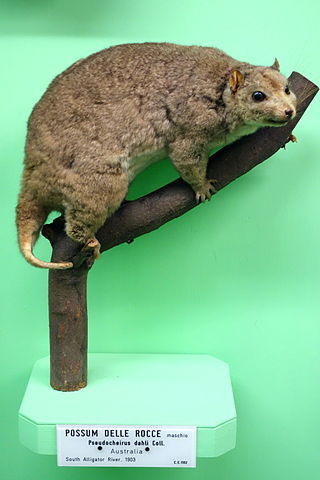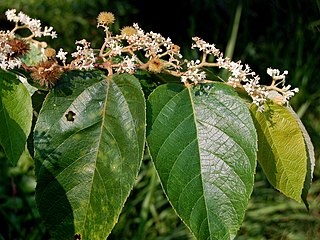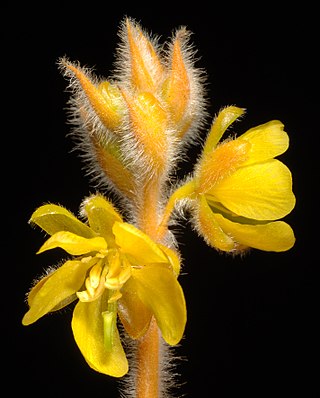
The rock-haunting ringtail possum, also known as the rock ringtail possum, is a species of Australian possum. It is found in rocky escarpments in the Kimberley, Arnhem Land and Gulf of Carpentaria across Western Australia and Northern Territory and just passing the Queensland border. It is also found on Groote Eylandt. It is the only species in the genus Petropseudes, but is part of the group including the common ringtail possum.

Melicope elleryana, commonly known as pink flowered doughwood, pink evodia, corkwood, or saruwa, is a species of rainforest shrub or tree in the family Rutaceae, and is native to New Guinea, parts of eastern Indonesia, the Solomon Islands and northern Australia. It has trifoliate leaves and pink to white, bisexual flowers arranged in panicles in leaf axils.

Myoporum acuminatum, commonly known as waterbush, pointed boobialla or mangrove boobialla, is a flowering plant in the figwort family Scrophulariaceae and is endemic to eastern Australia. It grows in rainforest or wet eucalyptus forest near the coast and in the Coastal Ranges, and is occasionally associated with mangroves. Occasionally it is found in the drier rainforests. It grows naturally as far south as Mimosa Rocks National Park in far south eastern New South Wales, and north to Fraser Island in Southern Queensland.

Micromelum minutum, commonly known as limeberry, dilminyin. kimiar margibur, tulibas tilos (Philippines), sesi (Indonesia) and samui (Thailand), is a species of small tree or shrub in the citrus plant family Rutaceae. It occurs from India and Indochina to Australia. It has pinnate leaves with egg-shaped to lance-shaped leaflets, hairy, pale green or creamish, scented flowers arranged in large groups and yellow to orange or red, oval to spherical berries in dense clusters.

Acacia leptocarpa, commonly known as north coast wattle, is a shrub or small tree native to New Guinea and coastal regions of northern Australia.

Acacia longissima, known colloquially as long-leaf wattle or narrow-leaf wattle, is a species of Acacia native to eastern Australia.

Acacia spondylophylla, commonly known as curry wattle or spine-leaf wattle, is a small, flat topped shrub native to central and western Australia. The leaves, which are arranged on spaced whorls around the stem, have a distinctive curry-like smell.

Trema tomentosum, also known as T. tomentosa and commonly called poison peach, is a shrub or tree in the family Cannabaceae native to the Indian subcontinent, south east Asia, through the islands of the south west Pacific, and the east coast and northern half of Australia.

Bossiaea arenicola is a species of flowering plant in the family Fabaceae and is endemic to a far north Queensland. It is a shrub or small tree with broadly elliptic to more or less round leaves, and yellow and pale greenish flowers.

Alphitonia whitei is a species of flowering tree in the family Rhamnaceae, that is endemic to Queensland in Australia. It is locally known as red ash, red almond or sarsaparilla. When twigs or leaves are broken, a sarsaparilla or liniment type scent is emitted.

Commersonia bartramia, commonly known as brown kurrajong, is a species of flowering plant in the family Malvaceae and is native to Southeast Asia, the Northern Territory, Queensland and New South Wales. It is a tree or shrub with heart-shaped to egg-shaped leaves much paler on the lower surface, and sometimes with fine, irregular teeth on the edges.
Memecylon caeruleum is a shrub or tree species in the Melastomataceae family. It is found from New Guinea, west through Southeast Asia to Tibet, Zhōngguó/China. It has become an invasive weed in the Seychelles. It has some local use for wood and food.
Memecylon cantleyi is a shrub or tree species in the Melastomataceae family. The flowers are white and vivid blue. The plant is native to an area from Borneo to Sumatra to Thailand. A name given to the tree in Malaysia, nipis kulit, translates as "calamondin bark".

Senna notabilis, commonly known as cockroach bush, is a species of flowering plant in the legume family Fabaceae, and is endemic to northern Australia. It is an erect, softly-hairy, annual or perennial shrub with pinnate leaves with six to twelve pairs of lance-shaped leaflets, and yellow flowers arranged in groups of twenty to thirty, with seven fertile stamens in each flower.

Cryptandra propinqua is a species of flowering plant in the family Rhamnaceae and is endemic to south-eastern continental Australia. It is a shrub with many branches, more or less linear leaves, and spike-like clusters of white, tube-shaped flowers.

Heptapleurum ellipticum, commonly known in Australia as the climbing umbrella tree, is a plant in the family Araliaceae native to the Indian subcontinent, Indochina, Malesia, Papuasia and Australia.

Androcalva loxophylla is a species of flowering plant in the family Malvaceae and is endemic to northern Australia. It is a shrub with spreading or low-lying branches, oblong to broadly elliptic leaves and clusters of 4 to 20 yellow flowers.

Senna cardiosperma is a species of flowering plant in the family Fabaceae and is endemic to the western half of Australia. It is an erect shrub or small tree with pinnate leaves, the number and shape of the leaflets depending on subspecies, yellow flowers with ten fertile stamens in each flower, and flat pods.

Debregeasia australis, commonly known as china grass or native ramie, is a plant in the nettle family Urticaceae endemic to Queensland, Australia.

Wilkiea cordata is a species of flowering plant in the family Monimiaceae, and is endemic to north-east Queensland. It is a shrub or small tree with oblong leaves, male and female flowers on separate plants, male flowers with stamens in 2 pairs, female flowers with about 25 carpels, and the fruit is an oval drupe with a yellow receptacle with an orange tinge.



















